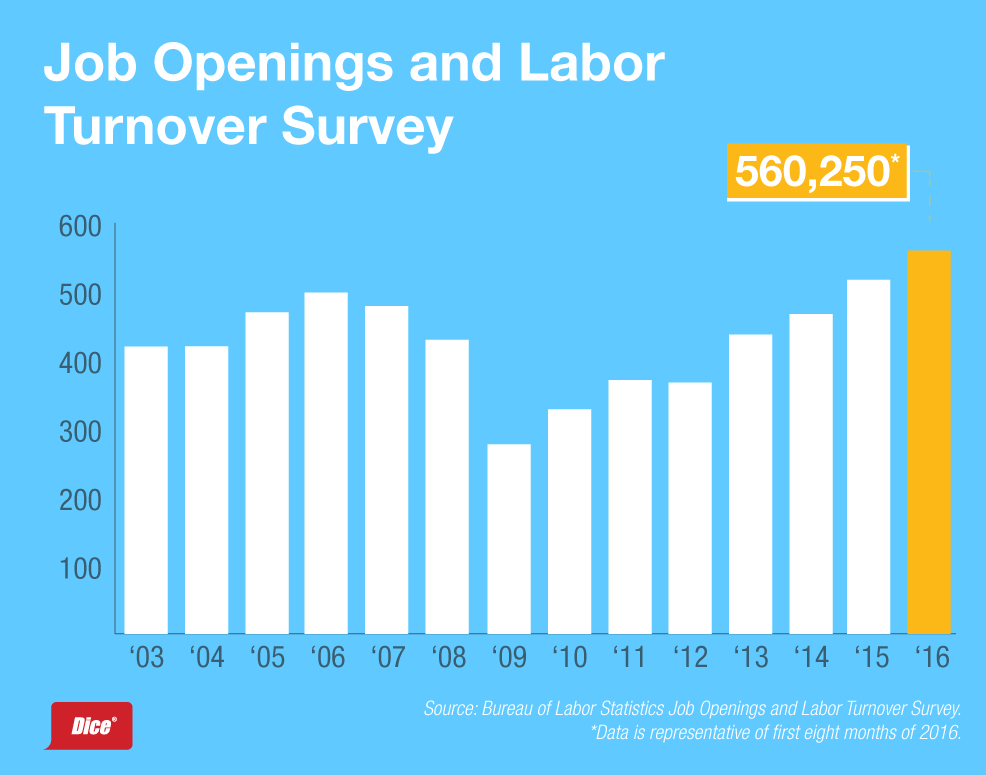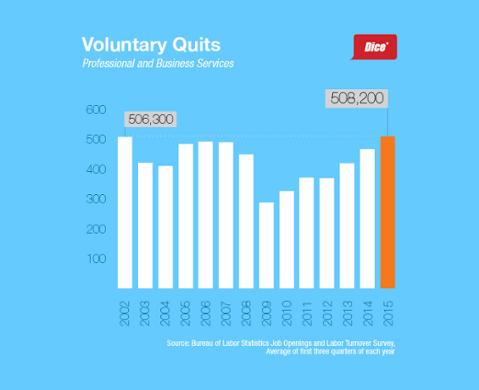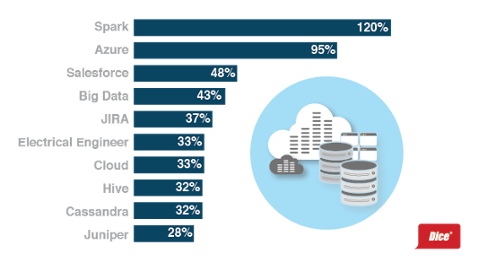 When the economy is good, professionals are more inclined to leave their current positions in search of better jobs. For employers, that behavior creates more opportunities to land top talent interested in higher salaries and perks—but it also makes it harder to retain top performers. Rising attrition can deeply affect a tech firm’s bottom line, adding to the costs of hiring and training new team members. According to Dice’s analysis of the latest turnover data from the U.S. Bureau of Labor Statistics (BLS), voluntary quits in the Professional and Business services category have averaged 560,250 per month for the first eight months of 2016, the timeframe for which we have finalized data. That’s a substantial increase over the same period in 2015, when voluntary quits averaged 507,875 per month. Dice’s recent analysis of its own data suggested that tech professionals are more than happy to migrate across state lines, or even move from one end of the country to the other, in order to find a job that matches their needs and desires. Many of these migration patterns are regional, such as between Washington, DC and the neighboring states of Virginia and Maryland. The high rate of voluntary quits, combined with tech pros’ willingness to move far away to land new opportunities, opens up fresh opportunities for employers with the budget for top talent. Companies in some of the nation’s up-and-coming tech hubs—places like Raleigh, NC, and Salt Lake City, UT—can use this trend to their advantage, appealing to tech pros who want a cheaper cost of living or superior work-life balance. As for companies that want to keep their talent in place, a strong retention strategy is a must-have. Internal surveys and other measures can determine the priorities of employees, but it’s up to managers to ensure that the right mix of incentives are put in place to ensure that teams remain productive (and profitable).
When the economy is good, professionals are more inclined to leave their current positions in search of better jobs. For employers, that behavior creates more opportunities to land top talent interested in higher salaries and perks—but it also makes it harder to retain top performers. Rising attrition can deeply affect a tech firm’s bottom line, adding to the costs of hiring and training new team members. According to Dice’s analysis of the latest turnover data from the U.S. Bureau of Labor Statistics (BLS), voluntary quits in the Professional and Business services category have averaged 560,250 per month for the first eight months of 2016, the timeframe for which we have finalized data. That’s a substantial increase over the same period in 2015, when voluntary quits averaged 507,875 per month. Dice’s recent analysis of its own data suggested that tech professionals are more than happy to migrate across state lines, or even move from one end of the country to the other, in order to find a job that matches their needs and desires. Many of these migration patterns are regional, such as between Washington, DC and the neighboring states of Virginia and Maryland. The high rate of voluntary quits, combined with tech pros’ willingness to move far away to land new opportunities, opens up fresh opportunities for employers with the budget for top talent. Companies in some of the nation’s up-and-coming tech hubs—places like Raleigh, NC, and Salt Lake City, UT—can use this trend to their advantage, appealing to tech pros who want a cheaper cost of living or superior work-life balance. As for companies that want to keep their talent in place, a strong retention strategy is a must-have. Internal surveys and other measures can determine the priorities of employees, but it’s up to managers to ensure that the right mix of incentives are put in place to ensure that teams remain productive (and profitable). Dice Report: Tech Turnover Stays Strong
 When the economy is good, professionals are more inclined to leave their current positions in search of better jobs. For employers, that behavior creates more opportunities to land top talent interested in higher salaries and perks—but it also makes it harder to retain top performers. Rising attrition can deeply affect a tech firm’s bottom line, adding to the costs of hiring and training new team members. According to Dice’s analysis of the latest turnover data from the U.S. Bureau of Labor Statistics (BLS), voluntary quits in the Professional and Business services category have averaged 560,250 per month for the first eight months of 2016, the timeframe for which we have finalized data. That’s a substantial increase over the same period in 2015, when voluntary quits averaged 507,875 per month. Dice’s recent analysis of its own data suggested that tech professionals are more than happy to migrate across state lines, or even move from one end of the country to the other, in order to find a job that matches their needs and desires. Many of these migration patterns are regional, such as between Washington, DC and the neighboring states of Virginia and Maryland. The high rate of voluntary quits, combined with tech pros’ willingness to move far away to land new opportunities, opens up fresh opportunities for employers with the budget for top talent. Companies in some of the nation’s up-and-coming tech hubs—places like Raleigh, NC, and Salt Lake City, UT—can use this trend to their advantage, appealing to tech pros who want a cheaper cost of living or superior work-life balance. As for companies that want to keep their talent in place, a strong retention strategy is a must-have. Internal surveys and other measures can determine the priorities of employees, but it’s up to managers to ensure that the right mix of incentives are put in place to ensure that teams remain productive (and profitable).
When the economy is good, professionals are more inclined to leave their current positions in search of better jobs. For employers, that behavior creates more opportunities to land top talent interested in higher salaries and perks—but it also makes it harder to retain top performers. Rising attrition can deeply affect a tech firm’s bottom line, adding to the costs of hiring and training new team members. According to Dice’s analysis of the latest turnover data from the U.S. Bureau of Labor Statistics (BLS), voluntary quits in the Professional and Business services category have averaged 560,250 per month for the first eight months of 2016, the timeframe for which we have finalized data. That’s a substantial increase over the same period in 2015, when voluntary quits averaged 507,875 per month. Dice’s recent analysis of its own data suggested that tech professionals are more than happy to migrate across state lines, or even move from one end of the country to the other, in order to find a job that matches their needs and desires. Many of these migration patterns are regional, such as between Washington, DC and the neighboring states of Virginia and Maryland. The high rate of voluntary quits, combined with tech pros’ willingness to move far away to land new opportunities, opens up fresh opportunities for employers with the budget for top talent. Companies in some of the nation’s up-and-coming tech hubs—places like Raleigh, NC, and Salt Lake City, UT—can use this trend to their advantage, appealing to tech pros who want a cheaper cost of living or superior work-life balance. As for companies that want to keep their talent in place, a strong retention strategy is a must-have. Internal surveys and other measures can determine the priorities of employees, but it’s up to managers to ensure that the right mix of incentives are put in place to ensure that teams remain productive (and profitable). 


